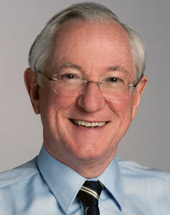Sean Solomon, PhD

Sean Solomon is the director of Lamont Doherty Earth Observatory of Columbia University, the largest of the Earth Institute’s research centers. Prior to arriving at Columbia, Solomon served for 19 years as director of the Carnegie Institution’s Department of Terrestrial Magnetism in Washington, D.C., where his research focused on planetary geology and geophysics, seismology, marine geophysics, and geodynamics. From 1972 to 1992, Solomon was a member of the faculty of the Department of Earth, Atmospheric, and Planetary Sciences at the Massachusetts Institute of Technology (MIT). He has led or been involved in oceanographic expeditions on Earth as well as spacecraft missions to the Moon, Venus, Mars, and Mercury. From 1996 to 1998, he was president of the American Geophysical Union, the world’s largest organization of Earth and space scientists.
Correspondingly, Dr. Solomon is the principal investigator for NASA’s MESSENGER mission to Mercury, the planet closest to the Sun. The MESSENGER spacecraft was inserted into orbit about Mercury in March 2011 after traveling for nearly seven years through the inner solar system and has been continuously mapping the planet’s surface, interior, and environment since shortly after arrival. The mission discovered ice at Mercury’s north pole and will continue gathering information key to understanding the planet’s composition, geological and internal evolution, atmosphere, and magnetosphere until spring of this year. From 1998 to 2008, Solomon served on the executive council of the NASA Astrobiology Institute, which seeks to understand how life on Earth arose and its potential to exist elsewhere. Additionally, Dr. Solomon is involved in NASA’s GRAIL mission to the Moon, which launched in 2011 and mapped the Moon’s gravitational field in unprecedented detail. From 1982 to 2005, he was involved in both the Magellan mission to Venus and the Mars Global Surveyor mission.
Dr. Solomon is a member of both the National Academy of Sciences and the American Academy of Arts and Sciences and is the recipient of numerous awards. These include the Geological Society of America’s G. K. Gilbert Award for solving broad problems in planetary geology, and the American Geophysical Union’s Harry H. Hess Medal, given for outstanding research on the evolution of Earth and other planets. In 2014, he was awarded the National Medal of Science by President Obama. Lastly, when Dr. Solomon stepped down as a director at Carnegie in 2011, colleagues arranged to have a previously discovered asteroid named after him. Asteroid 25137 Seansolomon, about a mile and half wide, is currently orbiting the sun between Mars and Jupiter.
Dr. Solomon is a graduate of the California Institute of Technology, and in 1971, received his PHD at MIT, with a Fannie and John Hertz Fellowship.
Graduate Studies
Awards
1995, Member, American Academy of Arts & Sciences; 1999, Arthur L. Day Prize and Lectureship, National Academy of Sciences; 2000, Member, National Academy of Sciences; 2012, National Medal of Science, National Science Foundation; 1995, Fellow, American Association for the Advancement of Science